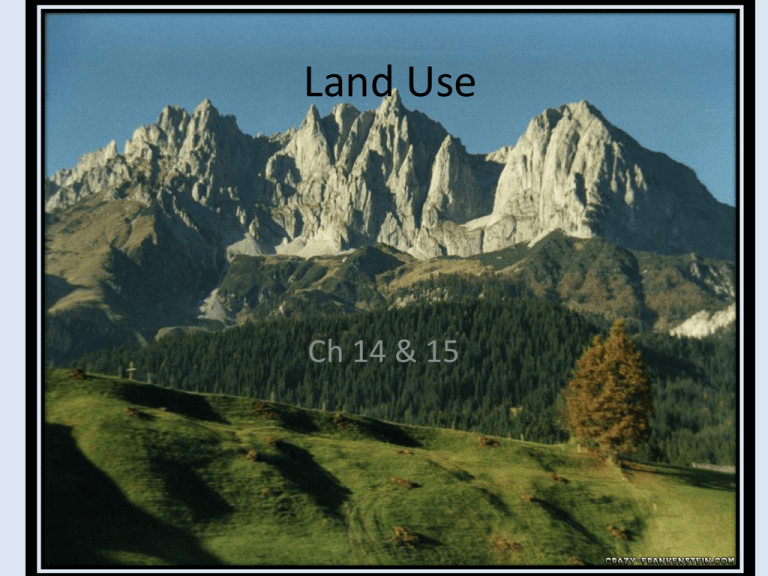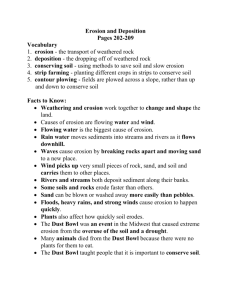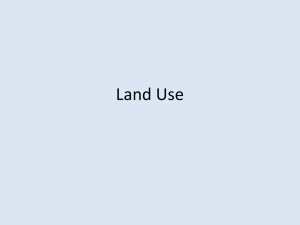Land Use - My Blog
advertisement

Land Use Ch 14 & 15 Land Use Categories • • • • Urban Agricultural Forests Parks and protected Urban • For the first time, more people live in cities than on rural land • Mass urbanization continues – Movement to cities from rural lands • Advantages: – Jobs more plentiful and centrally located – More efficient use of land per person • “vertical housing” • Infrastructure reaches many per given area Problems with Urbanization • Unplanned growth results in urban sprawl • Urban lands spread into arable land • Growth exceeds capacity of infrastructure, leading to urban crises – When population growth exceeds governments’ abilities to build water, sewer, sanitation, power, roads, schools • Development onto marginal lands – Encroaching into farmland, or too close to other natural features, such as cliffs or the Everglades. • Higher strain on surrounding rural land to serve urban needs (“ecosystem services”) • Higher pollution rates • Heat islands (see p 386) Urban Heat Island Atlanta, GA http://www.law.georgetown.edu/clinics/hi/Cl imatePolicy.htm http://earthobservatory.nasa.gov/IOT D/view.php?id=7205 Sometimes Infrastructure can’t grow as fast as population, resulting in poor sanitation, unhealthy living conditions http://www.mole.my/content/mail-finallyarrives-rio-favela http://www.laputan.org/mud/ Called “urban crisis” Open sewer in shanty town http://www.indymedia.ie/article/94825 Land Use Planning • Complex and can be controversial – Many competing interests: – Developers, environmentalists, current residents, retail owners • Geographic Information Systems (GIS) – Multilevel maps used to store many layers of information for effective planning Land Use • Planning Mass Transit – publicly subsidized people movers. – Integral part of effective land use plan – Saves on infrastructure costs Miami Light Rail Pittsburgh Subway System – These make most sense where population density is highest Mass Transit in Atlanta Urban Open Spaces • Provide some ecosystem services, – Recreation – Air cooling – Air exchange • Atlanta Greenway – under way • http://beltline.org/about/the-atlanta-beltlineproject/similar-projects/the-midtowngreenway-mn/ • Chattahoochee River Trails • etc Agricultural • Crops – Arable land = land that can be planted for crops – Only about 10% of land surface on earth is arable – Shrinking daily, due to urbanization, topsoil erosion and desertification • Range and pasture – Soil not rich enough for crops, but animals can “turn it into food” • Livestock – Including CAFO’s • Concentrated Animal Feed Operations • Aquaculture – Fish farming (includes shellfish) – Hydroponics Crops • Farming methods for growing crops have become more and more efficient to feed the growing population – More food produced for each acre of land = higher yield • Strains on crops have required more use of chemical fertilizers, pesticides and herbicides • Monoculture depletes soil of nutrients, creating need for inorganic chemical fertilizers • Pesticides and herbicides create resistant insects and weeds, creating the need for increasingly stronger poisons Topsoil • surface layer of land that contains lots of nutritious organics, mixed with inorganic particles, that holds moisture and that plants grow well in • Topsoil erosion – arguably the greatest environmental problem, next to population growth • Created dustbowl of ‘30’s http://en.wikipedia.org/wiki/Dust_Bowl http://en.wikipedia.org/wiki/Dust_Bowl • The Dust Bowl, or the Dirty Thirties, was a period of severe dust storms causing major ecological and agricultural damage to American and Canadian prairie lands from 1930 to 1936 (in some areas until 1940). The phenomenon was caused by severe drought coupled with decades of extensive farming without crop rotation, fallow fields, cover crops or other techniques to prevent wind erosion.[1] Deep plowing of the virgin topsoil of the Great Plains had displaced the natural deep-rooted grasses that normally kept the soil in place and trapped moisture even during periods of drought and high winds. Dust Bowl – topsoil erosion During the drought of the 1930s, without natural anchors to keep the soil in place, it dried, turned to dust, and blew away eastward and southward in large dark clouds. At times the clouds blackened the sky reaching all the way to East Coast cities such as New York and Washington, D.C. Much of the soil ended up deposited in the Atlantic Ocean, carried by prevailing winds, which were in part created by the dry and bare soil conditions. These immense dust storms—given names such as "Black Blizzards" and "Black Rollers"—often reduced visibility to a few feet (around a meter). The Dust Bowl affected 100,000,000 acres (400,000 km2), centered on the panhandles of Texas and Oklahoma, and adjacent parts of New Mexico, Colorado, and Kansas.[2] Dust Bowl – topsoil loss http://en.wikipedi a.org/wiki/The_Gr apes_of_Wrath • Millions of acres of farmland became useless, and hundreds of thousands of people were forced to leave their homes; • many of these families (often known as "Okies", since so many came from Oklahoma) migrated to California and other states, where they found economic conditions little better during the Great Depression than those they had left. • Owning no land, many became migrant workers who traveled from farm to farm to pick fruit and other crops at starvation wages. Author John Steinbeck later wrote The Grapes of Wrath, which won the Pulitzer Prize, and Of Mice and Men, about such people. Topsoil erosion http://www.swac.umn.edu/classes/soil2125/doc/s10chap3.htm Sheet erosion http://www.civil.ryerson.ca/stormwater/menu_5/index.htm Sheet and Rill Erosion http://www.geo.fu-berlin.de/fb/elearning/geolearning/en/soil_erosion/types/index.html Gully erosion • Rills can expand into gullies Gully Erosion • Providence Canyon, GA • Created entirely from land mismanagement • Cotton had been farmed here Providence Canyon Topsoil erosion facts from Cornell University study The study, which pulls together statistics on soil erosion from more than 125 sources, reports: • The United States is losing soil 10 times faster -- and China and India are losing soil 30 to 40 times faster -- than the natural replenishment rate. • The economic impact of soil erosion in the United States costs the nation about $37.6 billion each year in productivity losses. Damage from soil erosion worldwide is estimated to be $400 billion per year. • As a result of erosion over the past 40 years, 30 percent of the world's arable land has become unproductive. • About 60 percent of soil that is washed away ends up in rivers, streams and lakes, making waterways more prone to flooding and to contamination from soil's fertilizers and pesticides. • Soil erosion also reduces the ability of soil to store water and support plant growth, thereby reducing its ability to support biodiversity. • Erosion promotes critical losses of water, nutrients, soil organic matter and soil biota, harming forests, rangeland and natural ecosystems. • Erosion increases the amount of dust carried by wind, which not only acts as an abrasive and air pollutant but also carries about 20 human infectious disease organisms, including anthrax and tuberculosis. http://www.news.cornell.edu/stories/march06/soil.erosion.threat.ssl.html desertification Loss of topsoil results in land drying and desert expanding into it. Desertification: dust storm over Mediterranean Sea http://amazingdata.com/world-day-to-combat-desertificationand-drought-special/ Desertification Most vulnerable areas are in red http://en.wikipedia.org/wiki/File:Desertification_map.png Salinization • The accumulation of salts in the soil • Common problem in Arizona/California, where soil is naturally salty • And rainfall is low • Irrigation with salty groundwater or surface water • Salts get left behind Solutions include: Planting tree lines to try to break up the wind http://amazingdata.com/world-day-to-combat-desertificationand-drought-special/ Topsoil solutions • • • • • • • • Contour farming and strip cropping Crop rotation, including legumes Letting fields “lie fallow” No-till farming Cover crops Drip irrigation systems Terracing http://kids.britannica.com/comptons/artEnriching soil with compost 56029/An-aerial-view-of-farmland-inMinnesota-shows-the-unique Range and Pasture Land • Topsoil too thin to support crops • Cattle and other livestock can graze and turn “inedible plants” into food • Overgrazing becoming a problem – Plants cannot recover fast enough http://www.kkl.org.il/kkl/english/main_subject/curb%20global%20warmi ng/livestock%20grazing-combats%20or%20spreads%20desertification.x Forests http://jerryd greer.wordpr ess.com/200 8/04/19/joyc e-kilmermemorialforestnantahalanational- Three types: • Virgin – never been cut / • Native – forest that is planted and managed • Tree farms – areas where trees are planted in rows and harvested like crops forest-nc – Georgia has a huge industry of tree farms http://www.kynd.com/~finest/retail.htm Loblolly tree farm in Georgia Notice: •Monoculture •No growth on forest floor •No biodiversity http://www.flickr.com/photos/41460075@N08/4147750657/si zes/o/in/photostream/ Used for pulp and paper industry Forests: Deforestation Clear cutting • removing ALL the trees in an area • Cheaper • More erosion http://www.thecroc.org/crocblog/2 009/10/clearcut-for-the-climate/ Selective cutting • cutting only middle-aged or mature trees – More eco-friendly – Preserves biodiversity – Decrease erosion and fire danger http://pdsblogs.org/pdsapes812/2012/01/0 6/responsible-forest-management/ Forests: Deforestation • Much deforestation of virgin forests is done to clear for agricultural uses – grazing and croplands http://www.time.com/time/health/article/0,8599,1904174,00.html Forests • Reforestation – Planting trees where they have been recently removed • “Afforestation” – Planting trees where they haven’t been for over 50 years • New England now contains more forest than it did a century ago Forests Benefits: • Carbon sink – trees take up and store carbon dioxide from the atmosphere • When trees are burned in clear cutting, all the Carbon stored in trees is released at once as CO2 (combustion) Parks and Preserves • Areas set aside to protect wildlife and habitat • Wilderness Areas are areas in which the land and the ecosystem it supports are protected from ALL exploitation • Open to hiking, fishing, boating (without motors) and camping • No road building or structures • National Parks are not wilderness areas Wilderness areas and national parks maps • http://www.wilderness.net/map.cfm • http://www.nps.gov/hfc/carto/nps-mapzoomify/nps-wall-map.html Parks and Preserves - threats • Overuse – Erosion – Trash – Degradation of area for wildlife • Many state and nationally held areas allow – Controlled deforestation – Fracking and oil drilling, etc CAFO’s • Concentrated Animal Feed Operations • Most livestock are raised this way in US and other developed countries • Pollute water ways and concentrated wastes can seep into groundwater • Mistreatment of animals • Animals eat only corn and grains – no free range CAFO chickens • http://www.jehovahjirehfarm.com/chicken.php Non-CAFO CAFO cows http://oklahomafarmreport.com/wire/cattlenews/5279988_ TCFAReactCAFORegs_202519.php CAFO pigs • Notice the cage is not large enough for them to lie down http://www.enlightenamsterdam.com/veganism.html CAFO manure management Note that manure must be carefully managed to avoid leaching into nearby waterways or groundwater http://www.enlightenamsterdam.com/veganism.html







